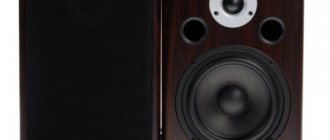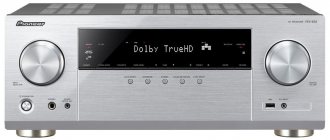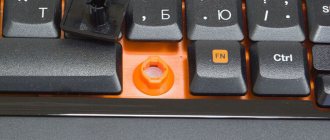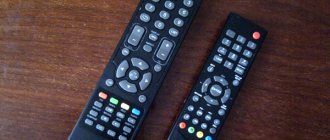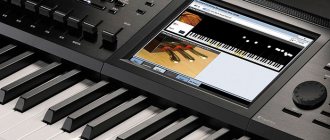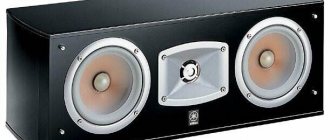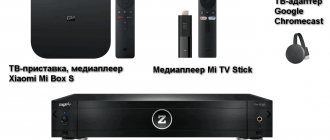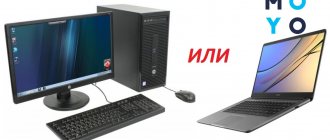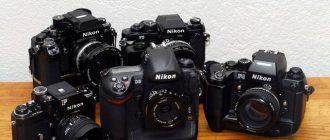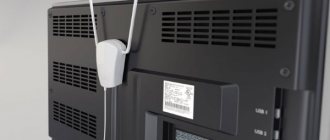The synthesizer is a universal musical instrument with enormous capabilities. Mastering it is not difficult for anyone who plays the piano at least a little, despite the fact that a good synthesizer in itself is worth an entire orchestra. Choosing a worthy instrument is not easy, but we are ready to help in this difficult task, and at the same time offer our own independent rating of the 10 best synthesizers for every taste and budget.
| Rating | Name | Characteristics | Price |
| 1 | Sonata SA-5401 | The best children's synthesizer | RUB 1,347 |
| 2 | Tesler KB-5410 | The best synthesizer for beginners | RUR 2,699 |
| 3 | CASIO CTK-2500 | The best amateur synthesizer | 11,000 R |
| 4 | YAMAHA PSR-S670 | The best professional synthesizer | RUB 40,200 |
| 5 | Akai MPK Mini MKII | Best MIDI Keyboard | RUB 9,988 |
Choosing a synthesizer: What to look for
Weight and size
The very first and most obvious parameters, which, however, are constantly forgotten. However, if you plan to carry the instrument with you frequently, say to rehearsal, a couple of extra pounds or ten centimeters in length can seriously complicate transportation.
The size of a synthesizer, first of all, depends on the number of keys: for a five-year-old child, 32 will be enough; for performing on stage, it is advisable to have at least 61, and to study music seriously - 88, like on a real piano. By the way, about the keyboard.
Keyboard
The keyboard is the most complex, heaviest and most expensive part of the synthesizer. In simple models it is light, weightless, pressed effortlessly and does not feel like a piano at all. More serious models, and even more so electric pianos, have keys that imitate real piano keys. The price difference between instruments with different types of keyboards can be huge, but it's worth it.
When choosing a synthesizer, you should pay attention to the sensitivity of the keyboard, how it reacts to changes in pressing force.
Among other things, the keyboards of modern synthesizers can be equipped with backlighting. For pros, this is not a particularly valuable feature, but those who are just learning to play will appreciate the dynamic backlighting.
Sound
The most important and at the same time the most subjective parameter. Different manufacturers achieve realistic sound from their gadgets in different ways, but the most popular methods are sampling and synthesis. In the first case, the sounds of real instruments are used, recorded in the synthesizer’s memory, while in the second, the sound is artificially modulated.
Good modern models with synthesized sound are indistinguishable from instruments that use sampling. Therefore, you should choose an instrument based on your subjective feelings about the sound it is capable of.
This largely depends on the audio system built into the synthesizer. As a rule, these are two mid-range speakers, but options are also possible. For example, a concert model does not have its own speakers at all.
Finally, analog synthesizers sound completely different than digital ones. The former are distinguished by a special old-fashioned charm, but the latter are easier to use, cheaper and not so capricious in operation.
Volume and expandability of sound banks
Basically, the more sound options a synthesizer has, the better. The main thing is that quantity does not dominate over quality. It’s better to have a device with a dozen or two good and popular tones than a Chinese self-playing game with three hundred unnecessary poor sounds.
The best option is an instrument with the ability to expand sound banks and add your own sounds. With it, the scope for creativity will not be limited by the basic capabilities of the instrument, but such models also cost quite a lot.
Screen
Not mandatory, but a handy feature. Managing sound banks, recording and playing music, learning to play and generally managing a complex digital device is much easier with a screen, albeit a small one. Of course, a large color screen is better than a small and monochrome one, but the price of a synthesizer with rich multimedia functionality is much higher.
Some synthesizers support connecting a smartphone or tablet as a screen - via wire, Bluetooth or Wi-Fi.
MIDI keyboard
The ability to connect your synthesizer to your PC and use it as a MIDI keyboard is a very useful feature. It’s much more convenient to work on music in some FL Studio with a MIDI keyboard.
Connection is possible both through special MIDI ports and simply via USB.
Interfaces
The presence of a USB port allows you not only to use the synthesizer as a MIDI keyboard. Via USB, you can often connect smartphones and tablets, flash drives with music and other external devices, and at the same time update the firmware. Wi-Fi and Bluetooth serve similar purposes.
There are special connectors for pedals. Their presence is not critical, because usually in synthesizers the pedal effect can be simulated manually, but it seriously expands the capabilities of the performer.
Nutrition
The synthesizer is not a button accordion and does not sing without electricity. The tool can be powered from the mains via a power adapter or from batteries. It is desirable that the synthesizer be able to operate from both sources: this way you can take it with you into nature and at the same time do without expensive batteries at home.
Synthesizers for entertainment
Yamaha Sonogenic SHS-300
A new budget model equipped with 37 dynamic keys, which also has 12 built-in tones. The synthesizer is distinguished by its compact overall dimensions and original design. There is a JAM function, with which the device can be synchronized with a gadget such as a tablet, mobile phone or laptop and play on it together with your favorite artists. The design includes a USB port, through which the synthesizer can be used as a midi keyboard. The body is plastic, painted blue. The device is very simple to use, suitable even for beginner musicians. There is a special mobile application Chord Tracker, which will automatically select and arrange the necessary notes. The user does not have to think about whether he has hit the melody or not, the same goes for the rhythm.
The synthesizer easily runs on batteries. There are several built-in effects - pitch bending, vibrato, sustain, so the user can, if necessary, give the music an original and interesting sound. The keyboard looks simple, but at the same time quite elegant. The instrument will look attractive both at home and at a concert.
Advantages:
- Low weight of the device;
- The sound is very clean;
- Long warranty period – two whole years;
- The keyboard has good ergonomics and is suitable for both children's and adult hands.
Flaws:
- The mobile application does not function correctly on all smartphones.
Yamaha Sonogenic SHS-300
Yamaha Sonogenic SHS-500
Another fairly lightweight model that runs on batteries. Synchronizes with any mobile device on which the proprietary Chord Tracker application is installed. You can synchronize via Bluetooth or via a cable connection. All you have to do is start the melody you like and press any keys. The notes will be selected by the device automatically, so the user will be able to give an original and professional solo even if he does not have the slightest idea about the correct placement of hands, keys, chords and other basics of musical literacy. There are 30 timbres in total, as well as a huge number of sound variations.
Also: From May 4 to May 7, Tronsmart Spunky Beat and Onyx Neo will be available at the lowest price on AliExpress!
If necessary, the user can change the tone and modulation, and take advantage of a large number of built-in effects. As a result, the performance of the melody will be very dynamic and expressive. The design of the synthesizer is quite solid, so it can be used not only at home, but also when performing in public. The keyboard includes 37 keys, the speaker volume is adjustable. The keys themselves are smaller in size and are pressure sensitive. In addition, there is a built-in equalizer and three preset songs. The range of effects is wide – reverb, modulation, transpose and chorus. The kit includes a power supply that allows you to connect the device to a standard electrical outlet.
Advantages:
- Attractive red plastic body;
- Well-designed ergonomics of the keys, so a child or teenager can use the tool;
- Can be used both at home and at performances;
- Operates from mains or batteries.
Flaws:
- Even for a semi-professional synthesizer it is expensive.
sonogenic Keytar 「SHS-500」 INSTRUCTIONAL VIDEO
Yamaha Sonogenic SHS-500
The best children's synthesizers
Sonata SA-5401
A simple children's model priced at about 1,400 rubles. 54 reduced keys. The keyboard is light and unweighted. There is a screen, training mode, auto accompaniment. 100 built-in tones. There is no input for pedals, but there are built-in acoustics, a microphone jack and a microphone included. More than a simple toy and generally an excellent option for introducing a child to the world of music, but not very suitable for serious activities.
Price: RUB 1,347
CASIO SA-77
A more impressive model from a respected manufacturer, but the price is twice as high - almost 6,000 rubles. Unweighted keyboard with 44 reduced keys, 100 built-in tones, 10 training melodies, two built-in speakers, headphone output. Display and training mode available. There is auto accompaniment and polyphony for 8 voices. It can be powered by batteries, but there is no power supply included. This is an ideal option for basic music learning.
Price: ₽ 6,000
Children's models
CASIO SA-47
Allows the child to take his first steps in the musical world more easily. The design has 32 small keys, which are well suited for children's fingers, but in terms of sound quality, this synthesizer is quite good. Its sound range includes 100 timbres, 50 different musical styles, and 8-note polyphony. In addition, the instrument has 5 buttons responsible for drums, a reed organ mode and a piano mode with a switching function. Due to its compact dimensions, this synthesizer is ideal for young musicians.
The weight of the device is small, the keys have a soft stroke, which allows the baby to play on it for a long time, and the fingers will not feel tired. The main thing is to place the synthesizer on a flat surface before turning it on; it will not slide on it due to the presence of rubberized feet. The design is made in retro style. The case is made of high-quality silver plastic with a matte finish, on which dust, fingerprints and other types of contamination will not be visible. There are also reliable and fairly powerful speakers that provide good quality sounds. It is worth noting that the synthesizer is equipped with a liquid crystal display on which you can read all the information necessary for the user. The device has a training mode: it includes 10 melodies that the baby is asked to repeat. If necessary, you can connect headphones.
Advantages:
- Excellent sound quality;
- Small overall dimensions;
- An informative liquid crystal display is provided;
- High-quality assembly;
- The weight is quite suitable for a small child;
- Powered by batteries or accumulators, can be powered from the mains.
Flaws:
- Some users feel that the speakers sound quiet.
CASIO SA-47
4. Shantou Gepai HS5416A
For a children's model, this design has a fairly large range of capabilities: 12 educational-type demo tunes are stored in the memory of this synthesizer. There are over two hundred key settings, exactly the same number of rhythm settings, and 7 types of drums at once. It is possible to change the volume and tempo. The child, if desired, can record a melody he has invented into the equipment’s memory, and then play it back. Like all other children's synthesizers, it has a very convenient learning function and a number of sound effects. The device comes with a microphone. The synthesizer can be powered by six AA batteries or by a power cord (the latter is supplied with it).
Of course, such a toy cannot be compared with a professional musical instrument, but it has a wide set of keys - 54 pieces, just like a classic piano. They are located quite compactly, so the child does not have to strain his hands too much to reach the desired key or play the required chord. There is no liquid crystal display here, but all the functions are already clear - the buttons are labeled. The device has a built-in acoustic system consisting of two speakers that produce stereo sound. If necessary, you can connect headphones to the synthesizer. As users note in their reviews, this model is well suited for both children and adults who are just beginning to be interested in music and playing various instruments.
Also: 10 of the best and most inexpensive laptops - how to choose?
Advantages:
- Many different operating modes;
- 54 keys;
- Possibility to work both from the mains and from batteries;
- Reliability and durability.
Flaws:
- May slip on the surface.
Shantou Gepai HS5416A
CASIO SA-78
This is a fairly high-quality synthesizer, despite the fact that it was originally created specifically for children. First of all, the manufacturers took good care of children's safety. The speakers are protected in such a way that a child cannot reach them in any way. The body is made of high quality matte plastic. The buttons are all made of soft rubber with a sensitive touch. The keys are made of glossy plastic, a little easily soiled, but this is not critical. There are 44 of them here.
The synthesizer runs either on batteries or on a special 9.5 V 1 A adapter, which is connected to a special connector located next to the headphone jack. If necessary, you can connect external speakers, which can significantly improve the sound quality of the device. The weight of the device is small - together with six batteries it barely reaches one and a half kilograms. The case has very convenient recesses for carrying it. Even a three-year-old child can easily carry it from place to place without straining himself. At the same time, the device has five additional buttons responsible for the percussion instrument mode, and there are tempo and volume controls. The central part of the device has a monochronous liquid crystal display. It displays a metronome indicating rhythm, staff and other useful information. In addition, there is a large yellow button that switches between piano and organ modes. If the synthesizer is turned on without use for five minutes, it will automatically turn off.
Advantages:
- Small overall dimensions and weight of the device;
- Quite acceptable sound quality;
- Works both from the network and from batteries;
- Can be used by adults too.
Flaws:
- Not detected.
CASIO SA-78
Synthesizer Yamaha PSS-E30
The model is characterized by excellent sound, the keyboard is compact and designed specifically for small children's fingers. In addition, the synthesizer has an expanded library of compositions, with the help of which it will be possible to form and direct the creative impulses of the child. The design is miniature and lightweight - even a five-year-old child can easily handle it. The instrument's tones are of high quality, and a wide range of various additional effects are provided - from animal voices to a locomotive whistle. A training mode is provided, through which the child will acquire the basics of musical literacy, and in a playful way. There are several difficulty levels for this mode. A large number of well-known and popular songs are preinstalled in the synthesizer’s memory, which the child is invited to learn.
The synthesizer has a built-in speaker system and a headphone jack with a standard 3.5 mm jack. The device can operate either from four AA batteries, or from a power bank, or via a USB slot it is connected to the mains via a power supply. There is an original Quiz mode that allows you to guess sound effects and sounded notes - this activity will be interesting not only for children, but also for adults. With its help, you can quickly and well develop your ear for music.
Advantages:
- Quite wide functionality of the tool;
- Well thought out ergonomics of the synthesizer;
- Made from quality materials;
- Can be used both in stand-alone format and connected to the mains;
- Low weight and overall dimensions;
- There are a large number of different modes.
Flaws:
- At first it will be difficult for a child to understand all the capabilities of this device.
Synthesizer Yamaha PSS-E30
Synthesizer Yamaha PSS-F30
The keyboard includes 37 keys, and the device operates on the basis of 32-note polyphony. In addition, the synthesizer has 120 tones of the highest quality and 114 styles that will surely interest the child. The model also has an intelligent automatic accompaniment system, thanks to which you can arrange a real home concert. The headphone jack allows you to enjoy silence while your child practices this instrument. The keyboard is small in size, so it is well suited for a child's small fingers. There is a wide library of compositions with the help of which small children can quickly and fully realize their creative impulses. The tool itself is small-sized and light in weight. There is also a Smart Chord function, which will allow you to play the instrument without even knowing the musical notation. The child will be able to compose his own compositions and play songs from the synthesizer’s memory.
The model has the ability to virtually play 117 instruments plus three more drum kits. It has a liquid crystal display, which displays all the information useful to the user. There is also a built-in metronome. The speaker system has a power of 1.4 W - quite enough for a child. There is no power supply included, you will need to purchase it separately; the synthesizer can also run on batteries. The weight without them is only 1.2 kg with overall dimensions of 506x54x201 mm.
Advantages:
- It has minimal dimensions - the synthesizer is suitable for a child aged 4 years and older;
- Smooth travel of all keys;
- The synthesizer can simulate a wide variety of instruments;
- You can play it without even having minimal knowledge of musical notation;
- An informative display is provided.
Flaws:
- The kit does not include a power supply - you will either have to change the batteries all the time or buy it separately;
- Low volume of the built-in speaker.
Yamaha PSS-F30 overview: Everything your child needs to start playing.
Synthesizer Yamaha PSS-F30
The Best Synthesizers for Beginners
Tesler KB-5410
Another inexpensive model that will help your child learn to play the instrument without spending extra money. Standard 100 built-in tones, polyphony for 8 voices, training mode with two training melodies, small display, microphone input and line output. 54 small, unweighted keys – hence the low weight and modest dimensions. There is nothing extraordinary here, but the price is quite reasonable - a little more than 3,200 rubles.
Price: RUB 3,290
CASIO CTK-1500
Perhaps the best model for beginning musicians from CASIO. For a very reasonable price of around 8,000 rubles, you will get a keyboard with 61 full-size, although unweighted, keys, polyphony for 32 voices, 120 built-in tones, 70 auto accompaniment styles and two 2-watt speakers. Pleasant sound, nice appearance, works from mains and batteries. An excellent tool with not the richest, but more than sufficient functionality for beginners.
Price: RUB 7,990
Synthesizers for beginning musicians
Medeli M17
This device is an improved version of the M15 model. This synthesizer was released into wide sales only a couple of years ago, but due to its excellent price-quality ratio it was able to instantly gain popularity among ordinary users. The developers of this model placed additional emphasis on making the sound as perfect as possible. Here all timbres are heard realistically and clearly. This was achieved largely due to the installation of a more modern tone generator and improvement of the effects professor. These changes make this instrument suitable not only for teaching or home use, but also for performing in small venues. The polyphony here is 64-note, which allows you to get high-quality sound for each of the built-in tones. In addition to them, the synthesizer has one hundred automatic accompaniment styles.
The keys have also undergone some changes compared to the older model. They are quite responsive in terms of pressing, which provides greater brightness and expressiveness of the melody. The built-in mixer allows you not only to customize the individual sound of each instrument, but also to save the entered data into the synthesizer’s memory. As users note, this model is a small musical laboratory that allows you to carry out various experiments with rhythms, effects and achieve completely different sounds of the same composition. For beginners, the developers have provided 110 educational melodies. The front panel has a liquid crystal display that facilitates operation of the device.
Advantages:
- The keys here are full-size;
- Acceptable overall dimensions;
- High-quality sound;
- Good acoustics;
- Light weight;
- Reliable assembly.
Flaws:
- Some keys may begin to creak after a certain time;
- The sound range is only 5 octaves - many users note that it would be better if there were 7.
Medeli M17
CASIO CTK-7200
Manufacturers have managed to pack a colossal amount of capabilities and a huge range of functions into this model. As people who have used such a device say, it combines both the synthesizer itself and an almost full-fledged arranger and workstation. In shape and overall dimensions, the keys here are no different from the keys of a piano, which allows people who have graduated from music school to use these instruments. They will not experience discomfort due to small keys, which is often the problem with many synthesizers. There are also a variety of useful features that make creating music quick and easy.
The synthesizer has over three hundred musical presets that perfectly connect voice and rhythm, regardless of the chosen style of music. The sound quality is also excellent - each selected instrument will sound like an acoustic one, and you can slightly change its parameters depending on your needs. One of the most interesting features is Audio Recorder: thanks to it, you can record from any external source, and the file will be saved on an external USB drive. The synthesizer has two audio inputs at once; it is possible to apply one of the many available effects to the instrument input.
Advantages:
- Reasonable cost;
- It is possible to record almost professional phonograms;
- You can record music and voice at the same time.
Flaws:
- Some keys begin to creak after a certain time - this does not affect the quality of the recording, but it can cause some discomfort for the musician.
CASIO CTK-7200
CASIO CTK-6200
This is one of the most compact semi-professional models from this manufacturer, which quickly gained popularity among users. The range of functions and useful qualities of this device is quite wide, so many people are surprised why so many features are provided for such a low price. The overall dimensions are small, although the keyboard here is full-size - it includes 61 dynamic keys. If necessary, you can select the most suitable sensitivity level, allowing you to use a wide variety of musical styles. If the user has some experience using such equipment, the sensitivity mode can be turned off completely, which allows the synthesizer to be used as a midi controller.
The internal capabilities are very rich: the range of possibilities has been expanded almost to a professional level, largely due to the presence of seven hundred built-in tones. There is an editor that allows you to create your own musical voices by layering. One-time polyphony includes 48 notes. In addition, the synthesizer has hundreds of preset effects, the same number of customizable ones, and there are ten types of reverb. The synthesizer's memory is extensive - it is designed for 5 compositions, each of which can contain up to 17 melodies, which in total amounts to over 12 thousand notes. There are slots for SD or SDHC memory cards, the capacity of which can reach 32 GB. Another very interesting feature is the “Music Presets”, which are a built-in library with about 300 different songs.
Advantages:
- High quality of tool manufacturing;
- Wide range of tools;
- Ease of use;
- Good value for money, and the quality is even significantly higher compared to the cost.
Flaws:
- There may be some learning problems.
CASIO CTK-6200
Yamaha PSR-E463|EW410
For an entry level, this tool is considered not too expensive. At the same time, the synthesizer is widely popular even among professional musicians, largely due to its excellent acoustic qualities; there is a large number of different tones. For such a device, it is characterized by relatively compact overall dimensions. The synthesizer is perfect for playing melodies of any genre and style. The keys are sensitive to the force of pressing them, and the built-in speakers are quite powerful. There are a decent number of latest features that cannot be found in other devices. Using Quick Sampling, you can load samples from any other devices into the design memory, for example, from a player, if you connect it via the AUX input. If you wish, you can record sound from any source and assign it to a specific key, thereby creating a wide library of sounds.
More: TOP 10 rating of the best airbrushes, how to choose a small paint sprayer
There is another original function called Groove Creator, through which you can almost instantly create an arrangement for dance and other music - just select the required beat, adjust the mix and adjust the groove. In this case, the track can be controlled interactively. The device has an enlarged keyboard - as many as 76 keys, the acoustic system is represented by a pair of 12 W speakers. There is also a concert grand piano tone. The synthesizer also has a training mode, a metronome and many other tools that will perfectly help the keyboard player when working with this synthesizer.
Advantages:
- Everything you need for an amateur game is present here;
- Extended keyboard format;
- Many additional functions;
- There is a training mode and many points that can help during performances.
Flaws:
- The keys are quite loud to press.
Yamaha PSR-E463|EW410
Synthesizer Yamaha PSR-E360
The capabilities of this synthesizer will be appreciated not only by beginning musicians, but also by fairly experienced or even professional performers. The device is equipped with 48-voice polyphony. The keys are pressure sensitive, allowing you to create your own playing style. The synthesizer also has a training program that includes several levels. With its help, you can master playing keyboard instruments much faster and improve your skills. The control panel is completely Russified (with the exception of only a few symbols), which makes using the tool even more convenient.
The synthesizer allows you to work with absolutely any musical composition. Its range includes 400 tones, characterized by samples of the highest quality, and there are also 130 styles of various accompaniments. The equalizer can be adjusted manually if necessary, and there is a reverberation effect, which allows you to personalize your performance. You can save your own music composition to the synthesizer's memory. To do this, just use the Record function. You can use the product as a standard speaker system, which connects to the sound source via a regular 3.5 mm jack.
Buy a good Yamaha PSR-E360 synthesizer for beginners and experienced musicians from the manufacturer!
Advantages:
- For entry level one of the best tools;
- A huge number of options;
- Fully Russified menu;
- Low weight of the device;
- Sounds interesting.
Flaws:
- An entry-level synthesizer could cost a little less.
Yamaha PSR-E360 Keyboard Overview
Synthesizer Yamaha PSR-E360
The best amateur synthesizers
CASIO CTK-2500
An instrument worth 11,000 rubles, intended not so much for a beginner as for an advanced amateur. This synthesizer is very similar to the previous model, but is equipped with advanced functionality. It has a similar 61-key keyboard, but has 400 built-in tones, 48-voice polyphony, 100 auto-accompaniment styles, transpose, reverb and metronome functions, as well as 60 educational melodies. Line input, headphone output, battery and mains operation - an excellent model for home use.
Price: ₽ 11,000
YAMAHA YPT-260
An analogue of the model is higher, but from another Japanese corporation and a little more expensive - around 11,500 rubles. There are 400 built-in tones, 32-voice polyphony, 130 auto-accompaniment styles, transposition, metronome, reverb, 112 melodies for training, the ability to record, and a stereo acoustic system with a total power of 5 watts. An excellent model for studying, and just for playing with your family or guests at your leisure.
Price: RUB 11,490
The best synthesizers for professionals
Professionals are demanding people who can do a lot, and therefore the functionality of entry-level synthesizers is no longer enough for them. Manufacturers develop high-quality tools especially for them, which, unfortunately, cost a lot of money. What is the reason for the increase in cost by at least 4-5 times?
First of all, it is worth noting that the functionality has expanded significantly. The models in our rating are able to reproduce, record and process approximately 10 times more sounds. At the same time, no one will teach you how to use all this, so there is no place for beginners here. Secondly, the presence of professional ports, which provides better sound quality. And yes, in this category, rare models have built-in acoustics. We bought a synthesizer for 100 thousand - if you please, buy high-quality speakers or headphones for it. Finally, quality - without exception, all models for professionals will have excellent build quality and sound, as well as high reliability. You can look at the best synthesizer models for professionals in our rating.
The best professional synthesizers
YAMAHA PSR-S670
Professional-grade tools are the most important part of any manufacturer’s range, so Yamaha pays special attention to them - and this model, priced at about 40,000 rubles, is no exception. It has everything a musician of any level needs: 61 semi-weighted full-size keys, the ability to connect pedals, 30 watts of built-in sound, 930 (!) tones and 409 effects, 230 auto accompaniment styles. Polyphony of 128 voices will handle even the most complex compositions. It is possible to record songs, up to 16 tracks each, in .wav format. There is a headphone output, two line outputs and USB ports. An excellent, fully functional device that is worth the money.
Price: ₽ 40,200
CASIO LK-266
The device is simpler than the previous one, but also not without its raisins. The main feature of this model is the backlit keyboard with 61 touch-sensitive keys. It looks cool and is useful for learning and learning new melodies. The rest is a standard gentleman's set: 400 tones, polyphony for 48 voices, 100 auto-accompaniment styles, transpose, metronome, reverb. Pedal input, mic input and headphone output. With a price of around 18,500 rubles, this is an excellent synthesizer.
Price: RUB 18,590
The best synthesizer manufacturers
KORG
The legendary synthesizer manufacturer, whose origins were an accordionist, a club owner and an engineer, began producing synthesizers already in the 70s. They went from organ to effects processors. The brand survived a merger, turning into a partnership, the purchase of the British Vox and the purchase of its own controlling share from Yamaha.
KORG micro KORG XL
The synthesizer with small keys and pressure sensitivity is lightweight and easy to transport, and is recognized as a popular model.
| KORG micro KORG XL | |
| Indicators | Meaning |
| Keys, pcs. | 37 |
| Timbre, set, pcs. | 128 |
| Polyphony | 8 |
| Auto accompaniment, styles | — |
| Headphones, output | 1 |
| Weight, kg | 2 |
KORG micro KORG XL
Advantages:
- multi-timbral function;
- with arpeggiator, vocoder;
- presence of reverberation;
- the ability to record songs;
- presence of headphone output.
Flaws:
- without a metronome.
KORG Pa1000
The synthesizer with built-in acoustics has a beautiful design and compact shape.
| KORG Ra 1000 | |
| Indicators | Meaning |
| Keys, pcs. | 61 |
| Songs, recording, tracks | 16 |
| Polyphony | 128 |
| Auto accompaniment, styles | 430 |
| Headphones, output | 1 |
| Weight, kg | 10.75 |
KORG Pa1000
Advantages:
- with memory card support;
- with touch screen;
- with pedal connection;
- with high sound quality;
- suitable for professional arrangements;
- Recommended for studio recordings and concert performances.
Flaws:
- No.
Casio Music
In the first post-war year 1946, the idea of the four Cascio brothers about the development of musical electronic and digital technologies was realized. Soon the first musical instruments for amateurs were created. Combining modern digital technologies and classic styles, the company has achieved a high level of recognition and popularity among customers. However, the principle of brand development is continuous improvement. Sound quality and acoustics are changing following the trends of the digital era. The people at Casio Music constantly keep their finger on the pulse of musical ideas and innovations, continuing to grow in unison with the musicians of the 21st century.
Casiotone
Production of the Casiotone line of synthesizers began in 1980.
Clear sound and accessibility for all categories of musicians - from beginners to adult masters - made the model popular.
CT-S 300
The stylish design of the instrument and the variety of functions - from training to creating tracks - allowed the model to become very popular. Mobility, power supply via an adapter or batteries, and the ability to connect to a PC are the undeniable advantages of the model.
| CT-S 300 | |
| Indicators | Meaning |
| Keys, pcs. | 61 |
| Accompaniment, styles, settings, synchronization | 77 |
| Speakers, cm | (13+6)*2 channels |
| Gain, W | 2,5 + 2,5 |
| Preset Songs | 60 |
| Weight, kg. | 3.3 |
Casiotone CT-S 300
Advantages:
- the ability to train with one hand - right or left, as well as with both;
- tablet/mobile game with connection;
- instant setup function;
- dance music creation mode;
- recording device with available MIDI format;
- function of saving personal settings and a button to launch them;
- 400 preset tones;
- the ability to connect a pedal via a special connector;
- the presence of an adapter and music stand included;
- 2 touch sensitivity positions with the ability to turn off;
- updated sound decay associated with the force of pressure on the keys;
- transmission of a spectrum of small shades with gradual release of pressure on the key;
- synthetic glossy key cover;
- functions for adding audio effects;
- without belonging to genres;
- automatic accompaniment with connection of ending, introduction and insertion, variations;
- availability of a metronome for home rehearsals;
- Recommended for entry-level musicians.
Flaws:
- not found.
Yamaha
A world-famous Japanese company with a history dating back to 1887, with its own philosophy of inspiration, aimed at admiring the result, and a call for sincerity, initiative, striving for more, and finishing what you started.
Yamaha guarantees the quality of its products obtained through improvement and the introduction of innovative technologies.
The company has over 7 dozen representative offices around the world, as well as subsidiaries.
Yamaha's priorities are expanding the research base and increasing production, long-term prospects and high quality of products, globalization through increasing the product range.
Model range MONTAGE
Best MIDI Keyboards
M-Audio Axiom AIR Mini 32
MIDI keyboards are a special type of device: synthesizers that are not designed to function independently, but to work in conjunction with a PC. This model connects to a computer via a USB port. 32 reduced keys make the device very compact - it can easily fit on a table. The keyboard is unweighted but touch sensitive. There is no acoustic system, but the gadget is not intended for independent operation. An excellent gadget for creativity that costs less than 7,000 rubles.
Price: RUB 6,930
Akai MPK Mini MKII
Ultra-compact MIDI keyboard with 25 small keys - only 318 mm in length and weighing 750 grams. Despite its modest size, there was room for an arpeggiator, touch-sensitive keys and the ability to connect pedals. A USB port is provided for connecting to a PC. A convenient tool for organizing a home mini-studio. With fairly wide possibilities, it does not cost too much - about 12,000 rubles.
Price: RUB 11,790
The Best Synthesizers for Learning
YAMAHA PSR-EW300
Rating: 4.9
This tool may seem expensive to some. Not everyone will want to spend 30 thousand rubles on it, especially if they are just learning to play the synthesizer. But the pleasure you get will definitely recoup your investment! And let's not forget that this model will suit you for many years. It is possible that you will never want to buy something better at all.
The YAMAHA PSR-EW300 includes an unweighted touch-sensitive keyboard. It uses 76 full-size keys. This number is ideal for learning to play - in the future you can easily switch to an acoustic piano, you will not notice any special changes. The sound here arises thanks to 48-voice polyphony. We couldn’t call it ideal, but its capabilities are definitely enough for many. The sound comes from the speakers located on the sides. If the 2.5 W power starts to be insufficient, you can use the linear output by connecting speakers to it. Also on the body of the synthesizer are USB Type B for connecting to a computer, a line input and a headphone output. The latter is designed for a 6.3 mm jack, so we recommend stocking up on an adapter.
The instrument turned out to be light and relatively small. The scales below him show 6.2 kg. So it's no surprise that it runs on batteries. The top of the synthesizer has virtually no free space. All sorts of buttons and switches are located here, and in the very center there is a place for a display, complemented by backlighting, albeit a small one. However, we will not argue with the fact that more professional models use an even larger number of buttons, and therefore they can boast more convenient controls.
A pedal can be connected to this synthesizer without any problems, but it must be purchased separately. As for the functions of the device, there are practically no complaints about them. 574 timbres certainly won’t seem like an insufficient number. Even a beginning musician is offered 165 auto accompaniment styles and 49 effects.
Advantages
- Long battery life available;
- A large number of tones;
- Numerous effects and auto accompaniment styles are available;
- There is a backlit display;
- The synthesizer turned out to be light;
- You can connect a pedal;
- A very large number of connectors;
- The keys are touch sensitive;
- Built-in training mode;
- A wide music stand is used.
Flaws
- Still not the best polyphony.
CASIO LK-S250
Rating: 4.8
The Japanese company Casio was born in 1946. She made a worldwide name for herself with calculators powered by a regular battery. Further more. For some time, Japan was the largest importer of electronics to the United States, and therefore Casio also became involved. At one time, it began to produce synthesizers that were distinguished by their excellent sound. Now these instruments are pleasing with their price, size, and number of timbres. The Japanese company's products have learned to imitate many other instruments - from strings to wind instruments and even drums. This applies even to such a relatively inexpensive model as the CASIO LK-S250.
Perhaps 400 tones are not the only advantage of this synthesizer. For example, many buyers like the gradually expanding capabilities of the device. As the buyer of this model in the DNS online store correctly noted: “There is USB - any software sees the instrument as a MIDI keyboard, and this means many years of use after outgrowing the capabilities of the synthesizer! This interface works with various Android programs, and the key backlight function also works.” Yes, backlit keys are actually implemented here - this feature is most useful when learning to play. It also allows you to quickly learn a particular melody.
It uses a dual-touch semi-weighted keyboard. The 61 keys present here are pleasingly full-size. Interestingly, the synthesizer equipped with such a keyboard manages to weigh only 3.4 kg. This is due to the fact that the creators tried to get rid of everything unnecessary. Thus, they were able to save money by reducing the final cost of the tool. It is surprising that with all this, the synthesizer still received a pair of speakers with a total power of 2.5 W, a small display, additional buttons and several switches. And only a professional musician will have the feeling that he is still missing a lot - more expensive models are “stuffed” with much more control elements.
The CASIO LK-S250 is powered by batteries. Or a power supply that connects to the appropriate connector. If we talk about nests, then there is almost everything that a beginner might need. For example, a headphone output will allow you not to disturb other people with your playing. There is also a line input, which may also be useful. Well, a nice bonus is the microphone input, which helps you record a song with vocals. Perhaps the only thing missing is a linear output.
The training mode is not the only useful feature available in this model. There is an equalizer, transpose and reverb. Not forgotten, of course, is the auto accompaniment. And the built-in metronome will allow you not to reach for your smartphone to activate this function.
Advantages
- A large number of connectors;
- Modest size and weight;
- Low cost;
- There is backlighting of the keys;
- There is a display;
- It is possible to connect pedals;
- Offline operation available;
- Large number of timbres;
- Good semi-weighted keyboard;
- There is a training mode.
Flaws
- No line output;
- Still not the largest number of buttons;
- The built-in speakers are not the best.
YAMAHA PSR-F51
Rating: 4.6
Many beginner synthesizers come with very modest speakers. So in the case of the YAMAHA PSR-F51, you will find a 2.5 W speaker system - a far from prohibitive figure. Unfortunately, this is a serious limitation. We could turn a blind eye to it if the device had the appropriate connectors to output sound to an amplifier and speakers. But there is only a headphone jack here. The minimum number of connectors is generally the main problem of this model. You can't even connect pedals to the synthesizer! What can I say, this model cannot be synchronized with either a computer or a smartphone. This is a fee for a low cost, which does not exceed 10 thousand rubles.
This tool belongs to the compact type. Most of its top panel is occupied by an unweighted keyboard. It consists of 61 full-size keys (that is, only one octave is missing). There are no special complaints about it, it’s pleasant and convenient to play. One can only regret the lack of sensitivity.
Despite the very low cost, the synthesizer is ready to offer 114 auto accompaniment styles. Just let's not forget that you won't be able to upload additional ones here. The Japanese musical instrument also received 120 tones. 32-voice polyphony is responsible for their sound. You can also note the presence of transpose, reverb and metronome. The synthesizer also has a simple training mode.
The Japanese equipped their creation with an average number of buttons. There is also a display here, but it is capable of displaying only three digits. That is why the use of this model cannot be called the most convenient. There is no doubt that you will want more in the future. To at least be able to split the keyboard into two parts, fully implement the Duo mode. Or to use such an instrument as a MIDI keyboard. The YAMAHA PSR-F51 review on Piano-inform.com focuses on all this.
Advantages
- Uses full-size keys;
- Modest size and weight;
- Very low cost;
- There is a training mode;
- Operates on batteries;
- The number of buttons cannot be called very small.
Flaws
- I would like better polyphony;
- Of the connectors, there is only a headphone jack;
- Not a very large number of styles and timbres;
- The keys have no touch sensitivity.
Comparison table of the best synthesizers
| Name | Main characteristics | Price |
| Sonata SA-5401 | 54 reduced keys, the keyboard is light, unweighted, there is a screen, a training mode, auto accompaniment, 100 built-in tones. | ₽ 1 347 |
| CASIO SA-77 | Unweighted keyboard with 44 reduced keys, 100 built-in tones, 10 training melodies, two built-in speakers, headphone output. | ₽ 6 000 |
| Tesler KB-5410 | Standard 100 built-in tones, polyphony for 8 voices, training mode with two training melodies, small display, microphone input and line output. | ₽ 3 290 |
| CASIO CTK-1500 | The keyboard has 61 full-size, albeit unweighted keys, 32-voice polyphony, 120 built-in tones, 70 auto-accompaniment styles and two 2-watt speakers. | ₽ 7 990 |
| CASIO CTK-2500 | The keyboard has 61 keys, but there are 400 built-in tones, 48-voice polyphony, 100 auto-accompaniment styles, transpose, reverb and metronome functions, as well as 60 educational melodies. | ₽ 11 000 |
| YAMAHA YPT-260 | 400 built-in tones, 32-voice polyphony, 130 auto accompaniment styles, transpose, metronome, reverb, 112 melodies for training, recording ability. | ₽ 11 490 |
| YAMAHA PSR-S670 | 61 semi-weighted full-size keys, the ability to connect pedals, 30 watts of built-in audio, 930 tones and 409 effects, 230 auto accompaniment styles. | ₽ 40 200 |
| CASIO LK-266 | Keyboard with 61 backlit touch-sensitive keys, 400 tones, 48-voice polyphony, 100 auto-accompaniment styles, transpose, metronome, reverb. | ₽ 18 590 |
| M-Audio Axiom AIR Mini 32 | Connects to your computer via USB, 32 reduced keys, the keyboard is unweighted but touch sensitive. | ₽ 6 930 |
| Akai MPK Mini MKII | For 25 small-sized keys - only 318 mm in length and weighing 750 grams, there is a USB port for connecting to a PC. | ₽ 11 790 |
Rating of the best synthesizers
| Nomination | Place | Name | Price |
| The Best Synthesizers for Learning | 1 | YAMAHA PSR-EW300 | 28 990 ₽ |
| 2 | CASIO LK-S250 | 20 990 ₽ | |
| 3 | YAMAHA PSR-F51 | 10 190 ₽ | |
| The Best Synthesizers for Hobbyists | 1 | CASIO PX-160 | 49 990 ₽ |
| 2 | CASIO WK-6600 | 32 990 ₽ | |
| 3 | Yamaha MX61 | 69 990 ₽ | |
| The best synthesizers for professionals | 1 | Nord Piano 4 | 189 990 ₽ |
| 2 | Kurzweil PC3LE8 | 129 100 ₽ | |
| Best MIDI Keyboards | 1 | Roland A-800PRO | 27 490 ₽ |
| 2 | Nektar Impact LX88 | 28 990 ₽ | |
| 3 | Novation Launchkey 61 | 25 961 ₽ |
FAQ
How to learn to play the synthesizer? As with any other musical instrument, you will need desire, patience and a lot of free time. You can enroll in a music studio, hire a tutor, or turn to the help of the almighty Internet. The main thing is not to rush, and everything will work out for you.
How to choose the right synthesizer for beginners? A not too complex instrument with 61 keys is suitable for a beginner. It is best to choose a synthesizer with backlit keys, a display and additional training programs.
How to connect a synthesizer to a computer? Modern synthesizers are usually connected to a PC via a standard USB port or via a MIDI port. It all depends on the model, so it’s better to read about the possibility of connecting and how to do it correctly in the instructions for your synthesizer.
Synthesizers: characteristics, types, types
- Digital. An output for transmitting an audio signal in digital form, usually via a coaxial S/P-DIF interface. The purpose is similar to linear outputs (see below), differing only in the type of connector and digital signal format. It can be useful, in particular, for connecting the synthesizer to a device that does not have line inputs, or if these inputs are busy. — USB B. A connector designed to connect the synthesizer to a computer or laptop as a peripheral device. This connection provides very extensive possibilities: it allows you to load new timbres, auto-accompaniment styles and melodies into the synthesizer, and edit existing ones; record the music being played on the computer (or copy onto it the music recorded in the memory of the synthesizer itself); use the instrument as an external MIDI keyboard; change various fine settings and troubleshoot problems, etc. The specific functionality available via a USB connection depends on the synthesizer model.
- MIDI. Output for transmitting MIDI signals (MIDI events) to external devices. MIDI is a specialized type of digital control signal used in musical instruments. This signal is generated when a key is pressed; it contains data about the press itself (duration, strength and speed), as well as the note number; Based on this signal, as well as the configured settings, the electronic “filling” of the synthesizer forms the sound of the required duration, timbre and other characteristics. Accordingly...but the MIDI output allows you to transmit MIDI events to an external device - a sequencer, sampler, another synthesizer, a computer (although it is more convenient to connect the instrument to a computer via USB), etc. This interface can be used for various purposes - recording MIDI, playing music through an additional synthesizer if the main model does not have the required timbre, etc.
- MIDI thru. An output intended for transmitting MIDI events received by the synthesizer via a MIDI input to another device (see “Inputs”). In this case, the stream of MIDI commands is transmitted unchanged, pressing the keyboard of the synthesizer does not affect it. This function may be useful in some situations involving connecting the instrument to several external devices at once. For example, if you need to control two others at once from one synthesizer, you can arrange such a system as follows: the MIDI output of the control synthesizer is connected to the MIDI input of the first controlled one, and the MIDI thru output of the first one is connected to the MIDI input of the second one. Thus, the control signal goes to both the first controlled synthesizer and, through it, to the second, whereas connecting both instruments directly would be difficult.
- On headphones. Specialized output for connecting headphones. Usually uses a mini-Jack 3.5 mm or Jack 6.35 mm connector - the first is equipped with the vast majority of modern headphones, the second is less common in “ears”, but is more reliable, and is also compatible with 3.5 mm through a simple adapter. Using “ears” when playing a synthesizer is convenient because only the musician can hear the music being played - this can be useful in situations where you need to exercise, but making noise is undesirable (for example, at late times of the day). In addition, some instruments do not have built-in acoustics, and you can only listen to them normally through additional equipment - the role of which can be played by headphones.
The Best Synthesizers for Hobbyists
CASIO PX-160
Rating: 4.9
Many synthesizers come with a shortened keyboard. When purchasing them, you will have to come to terms with the absence of one octave. If this is unacceptable to you, we recommend that you check out the CASIO PX-160. 88 full-size keys await you here! Moreover, this synthesizer uses a weighted keyboard with hammer action! The manufacturer has not forgotten the implementation of touch sensitivity of the keys. In short, your experience will be as similar as possible to when you play a full-fledged acoustic piano.
This model has been produced for many years. And it is in stable demand, so you will see it on store shelves for quite some time. The synthesizer is available in white, golden beige and black body colors. Despite its decent size, the tool does not have the largest number of additional buttons. But their number cannot definitely be called insufficient. As for the keys, they have a special coating, thanks to which the fingers do not slip even when playing very quickly - this is described in detail on Sollami.ru.
This tool was not created for beginners. Therefore, the manufacturer has already endowed it with 128-voice polyphony. He also built in a split keyboard mode for playing with two people - with so many keys this is quite relevant. Also, the Japanese did not skimp on connectors. You can connect two pairs of headphones to the synthesizer and output the sound to speakers via a line output. Or use the built-in acoustics, the power of which reaches 8 W. Well, USB Type B will allow you to use the instrument as a MIDI keyboard by connecting it to a computer. In this case, the disadvantage of a small number of timbres (there are only 18 here) becomes less noticeable.
Numerous reviews recommend this synthesizer even to advanced performers, albeit only as a second instrument. Beginning musicians will be absolutely delighted with the CASIO PX-160! We ourselves recommend looking towards this model, if only because of its keyboard - other manufacturers only build this into much more expensive synthesizers.
Advantages
- Comes with sustain pedal;
- The keyboard has hammer mechanics;
- Each key is full-size and three-touch;
- Built-in powerful speakers;
- Training mode available;
- There is a keyboard split function;
- Song recording possible;
- Excellent polyphony;
- There are two linear outputs;
- There are two headphone jacks.
Flaws
- The synthesizer cannot be called small and light;
- High price;
- Few timbres;
- The pedal glides on the floor due to its light weight.
CASIO WK-6600
Rating: 4.9
An excellent entry-level musical instrument, for which they ask for no more than 30 thousand rubles. For this money, the buyer gets a very large synthesizer, on the front panel of which there are 76 keys. Played music can be saved to an SD card. Despite the increased cost, the product also has only 48-channel polyphony. However, you can get much more out of it than using the devices discussed above.
There are a large number of auxiliary functions that will not interfere with any musician. In particular, you can highlight metronome, reverb, transpose, auto accompaniment and arpeggiator. Also worth noting is the ability to connect pedals and the presence of a pitch bend controller. All keys present here are touch sensitive (two levels of sensitivity). On the rear panel of the synthesizer you can find a line input, a microphone jack and a headphone output. The creators have not forgotten the USB Type B connector.
Advantages
- Built-in speakers with a power of 6 W each;
- 76 standard keys with touch sensitivity;
- 210 styles and 700 tones;
- Good sound processor with 48-channel polyphony;
- There is an LCD display and a data input wheel;
- An arpeggiator and many other useful functions are available;
- There is a 32-channel mixer;
- There are microphone and line inputs, as well as a headphone output;
- Can be connected to a computer via USB.
Flaws
- For some, after six months of use, the keys begin to make a grinding noise.
Yamaha MX61
Rating: 4.7
Another entry-level professional synthesizer, which includes 61 keys. Unlike cheaper models, the instrument offers USB and MIDI connections, as well as advanced VST and DAW control capabilities. The user has 1106 tones to choose from - such a number is extremely rare in this price segment. The synthesizer also has VCM effects that simulate electronic circuits.
With this instrument you can easily mix tones and split the keyboard. But most of all the buyer should be pleased with the polyphony, which here is 128-voice. Perhaps, just because of this fact alone, it is quite possible to think about being generous with 50 thousand rubles.
Advantages
- You can connect pedals;
- All keys are touch sensitive;
- Implemented a modulation and pitch change controller;
- Small size and weight (4.8 kg);
- A very large number of timbres;
- Well-implemented multitimbrality;
- Excellent sound processor with 128-voice polyphony;
- A large number of connectors.
Flaws
- Only 61 keys;
- There is no slot for a memory card;
- Not very convenient control of sound mixing.
